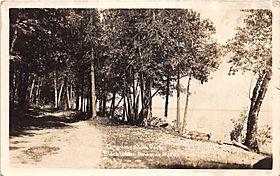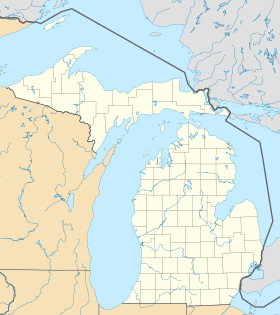Onaway State Park facts for kids
Quick facts for kids Onaway State Park |
|
|---|---|
|
IUCN Category III (Natural Monument)
|
|

Onaway State Park c. 1930
|
|
| Location | North Allis Township, Presque Isle County, Michigan |
| Nearest city | Onaway, Michigan |
| Area | 158 acres (64 ha) |
| Elevation | 682 feet (208 m) |
| Designation | Michigan state park |
| Established | 1920 |
| Administrator | Michigan Department of Natural Resources |
| Website | Onaway State Park |
|
Onaway State Park
|
|
| Built by | Civilian Conservation Corps |
| Architect | Ralph B. Herrick |
| NRHP reference No. | 09001066 |
| Added to NRHP | December 8, 2009 |
Onaway State Park is a fun outdoor spot in Michigan. It covers about 158 acres. You can find it on the southeast side of Black Lake. The park is in North Allis Township, which is part of Presque Isle County.
This park is located at the end of M-211. It's about five miles north of the town of Onaway. The park has sandy and rocky beaches. You'll also see big rock formations. There's a campground for overnight stays. A nature trail shows off many different kinds of trees. In 2009, Onaway State Park was added to the National Register of Historic Places. This means it's an important historical site.
Contents
Discovering Onaway State Park's Past
Onaway State Park opened in 1921. It was one of 13 parks created around that time. The Michigan State Park Commission started in 1919. Its goal was to find land for new state parks. In 1920, Presque Isle County gave 150 acres to the state. This land included a city park called "The Indian Orchard." It also had some private lands nearby.
Early Park Development
In 1921, work began to develop the park. Two small bathhouses and toilets were added. A picnic pavilion was already there. Two old farmhouses were made into a park store and a manager's home. By 1924, a new entrance and campgrounds were ready. A road for the campground was built in 1927. After the first manager's home burned down in 1931, a new one was built.
The Civilian Conservation Corps' Role
In 1933, the Civilian Conservation Corps (CCC) helped the park. The CCC was a program during the Great Depression. It gave jobs to young men. They set up a camp at Black Lake. Fifteen men were assigned to Onaway State Park. They fixed the entrance road. They also built a walking trail. In 1934, they started digging a basement for the pavilion.
More improvements came in 1935 and 1936. A parking area for 100 cars was created. A stone toilet building was built in the campground. It was designed by Ralph B. Herrick. In 1937, the pavilion was updated. Stone shelters were also added. The campground got bigger in 1942.
After the CCC program ended, more changes happened. New sanitation systems were added in the 1960s. More campsites were built in 1969. The park roads were paved in 1970.
Exploring Onaway State Park Today
Onaway State Park has different areas for visitors. There's a picnic area, a beach, and a campground.
Campground Areas
The campground has two parts. The lower campground was made in 1923. CCC workers added log, boulder, or concrete barriers in the 1930s. These barriers separated the campsites. A toilet building from 1937 is in the lower campground. It has limestone walls at the bottom and log walls on top. The upper campground was built in 1942. It sits on a bluff above the lower campground. These campsites have lots of shade. The roads there are angled for easy access.
Picnic and Beach Areas
The picnic area has tables and grills. They are spread out in a shady, grassy spot. The beach area has a pavilion and bathhouse. This building dates back to around 1917. It's made of logs with a sloped roof. It also has a porch that wraps around. A basement was dug under it in 1934. This basement is made of stone. The CCC also added a stone fireplace and changed the porch.
Fun Things to Do at Onaway State Park
Onaway State Park offers many activities for visitors. You can go fishing in the lake. Swimming is popular at the beach. There are picnic areas for outdoor meals. The park has a boat launch if you want to bring your boat. You can explore three miles of hiking trails. There's also a playground for kids. If you want to stay overnight, there's a cabin and a campground with 96 sites.


